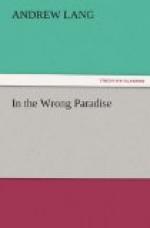Evidence, which is bound to be confirmatory, reaches us from an altar and from works of art. The one altar of Gladstone is by some explained as the pedestal of his statue, while the anthropological sciolists regard it simply as a milestone! In speaking to archaeologists it is hardly necessary even to touch on this preposterous fallacy, sufficiently confuted by the monument itself.
On the road into western England, between the old sites of Bristol and London, excavations recently laid bare the very interesting monument figured here.
[Sketch of monument: image1.jpg]
Though some letters or hieroglyphs are defaced, there can be no doubt that the inscription is correctly read G. O. M. The explanation which I have proposed (Zeitschrift fur Ang. Ant) is universally accepted by scholars. I read Gladstonio Optimo Maximo, “To Gladstone, Best and Greatest,” a form of adoration, or adulation, which survived in England (like municipal institutions, the game laws, and trial by jury) from the date of the Roman occupation. It is a plausible conjecture that Gladstone stepped into the shoes of Jupiter Optimus Maximus. Hence we may regard him (like Osiris) as the sum of the monotheistic conception in England.
This interpretation is so manifest, that, could science sneer, we might laugh at the hazardous conjectures of smatterers. They, as usual, are greatly divided among themselves. The Spencerian or Euhemeristic school,—if that can be called a school
“Where
blind and naked Ignorance
Delivers brawling judgments all
day long
On all things, unashamed,”—
protests that the monument is a pedestal of a lost image of Gladstone. The inscription (G. O. M.) is read “Grand Old Man,” and it is actually hinted that this was the petit nom, or endearing title, of a real historical politician. Weak as we may think such reasonings, we must regard them as, at least, less unscholarly than the hypothesis that the inscription should be read
“90 M.”
meaning “ninety miles from London.” It is true that the site whence the monument was excavated is at a distance of ninety miles from the ruins of London, but that is a mere coincidence, on which it were childish to insist. Scholars know at what rate such accidents should be estimated, and value at its proper price one clear interpretation like G. O. M.= Gladstonio Optimo Maximo.




